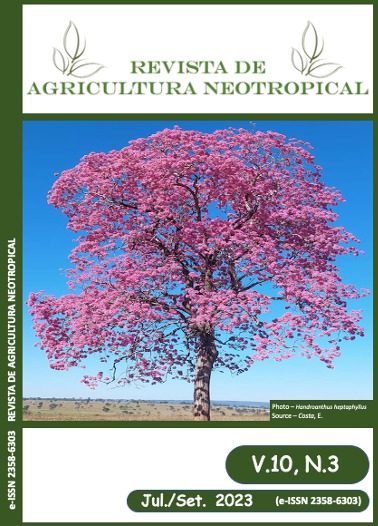SELECTION OF SOYBEAN LINES BASED ON A NUTRACEUTICAL IDEOTYPE
DOI:
https://doi.org/10.32404/rean.v10i3.7356Keywords:
Glycine max,, MGIDI, CorrelationAbstract
This study aims to select soybean lines with desirable nutraceutical characteristics under specific meteorological conditions in the selection environments. The experiment was conducted during the 2021/2022 harvest at Escola Fazenda, Regional University of the Northwest of the State of Rio Grande do Sul, located in Augusto Pestana- RS, Brazil. The experimental design was augmented blocks, with 27 populations of F2 generation, 118 lines of F5 generation, 70 lines of F8 generation, and 15 soybean cultivars as interim checks, arranged in three replications. The chemical composition of soybeans was evaluated using Near Infrared Spectroscopy - NIRS method to analyze various nutritional components. The IRC050 genotype exhibited a nutraceutical profile characterized by an increment in stearic fatty acid (STEAR) and reduction in fiber (FB) and mineral material (MM) contents. Among the F5 generation, the following genotypes were selected based on their nutraceutical traits: L174F5, L307F5, L322F5, L205F5, L190F5, L196F5, L219F5, L183F5, L301F5, L172F5, L198F5, L182F5, L319F5, L21F5, L188F5, L217F5, L302F5, L315F5, L36F5, L318F5, L211F5, L165F5, L321F5, and L179F5. The indirect selection of genotypes with higher levels of linoleic acid and protein was facilitated using the enzyme peroxidase.
References
(I) Bakal, H., Gulluoglu, L., Onat, B.Z., Arioglu, H. 2017. The effect of growing seasons on some agronomic and quality characteristics of soybean varieties in Mediterranean region in Turkey. Turkish Journal. Field Crop. 22(2), 187-196. https://doi.org/10.17557/tjfc.356213
(II) Barbosa, M.H., Carvalho, I.R, Silva, J.A.G., Magano, D.A., Souza, V.Q., Szareski, V.J., Lautenchleger, F., Hutra, D.J., Moura, N.B., Loro, M.V. 2021. Contribution of the additive genetic effects in soybean breeding aiming at the agronomic ideotype. Functional Plant Breeding Journal. 3(1), 1-9. http://dx.doi.org/10.35418/2526-4117/v3n1a1
(III) Bellinasso, A.V., Carvalho, I.R., Silva, J.A.G., Moura, N.B., Hutra, D.J., Loro, M.V., Bubans, V.E., Lautenchleger, F. 2021. Cover crops and their relationship with the qualitative and quantitative attributes of soybeans. Revista Brasileira de Agricultura, 96(1), 294-313. https://doi.org/10.37856/bja.v96i1.4260
(IV) Beninca, C.P., Franzener, G., Assi, L., Iurkiv, L.E.B., Costa, V.C., Nogueira, M.A., Stangarlin, J.R., Estrada, K.R.F.S.2008.
(V) Indução de fitoalexinas e atividade de peroxidases em sorgo e soja tratados com extratos de basidiocarpos de Pycnoporus sanguineus. Revista Arquivos do Instituto Biológico. 75(3), 285-292. https://doi.org/10.1590/1808-1657v75p2852008
(VI) Carvalho, N.M., Nakagawa, J. 2012. Sementes: ciência, tecnologia e produção. 5. ed. FUNEP, Jaboticabal.
(VII) CONAB. COMPANHIA NACIONAL DE ABASTECIMENTO. 2017. A produtividade da soja: análise e perspectivas. Safra 2017. v. 10. CONAB, Brasília. http://www.conab.gov.br. (accessed April 15, 2022).
(VIII) EMBRAPA. EMPRESA BRASILEIRA DE PESQUISA AGROPECUÁRIA. 2015. Teores de óleo e proteína em soja: fatores envolvidos e qualidade para a indústria. Comunicado Técnico, Embrapa, Londrina.
(IX) Ferraresi, L.M.D., Villela, F.A., Aumonde, T.Z. 2014. Desempenho fisiológico e composição química de sementes de soja. Revista Brasileira de Ciências Agrárias. 9(1), 14-18. https://doi.org/10.5039/agraria.v9i1a2864
(X) Follmann, D.N., Souza, V.Q., Cargnelutti Filho, A., Demari, G.H., Nardino, M., Olivoto, T., Carvalho, I.R., Silva, A.D.B., Meira, D., Meier, C. 2019. Agronomic performance and genetic dissimilarity of second-harvest soybean cultivars using REML/BLUP and Gower’s algorithm. Bragantia. 78(2), 197-207. https://doi.org/10.1590/1678-4499.20180194
(XI) Loro, M.V., Carvalho, I.R., Silva, J.A.G., Moura, N.B., Hutra, D.J., Lautenchleger, F. 2021. Artificial intelligence and multiple models applied to phytosanitary and nutritional aspects that interfer in the physiological potential of soybean seeds. Revista Brasileira de Agricultura. 96(1), 324-338. https://doi.org/10.37856/bja.v96i1.4258
(XII) Marcos Filho, J. 2015. Fisiologia de sementes de plantas cultivadas. Editora ABRATES - Associação Brasileira de Tecnologia de Sementes, Londrina.
(XIII) R Core Team. 2022 R: A language and environment for statistical computing. R Foundation for Statistical Computing, Vienna.
(XIV) Silva, C.E., Carrão-Panizzi, M.C., Mandarino, J.M.G., Leite, R.S., Mônaco, A.P.A. 2012. Teores de isoflavonas em grãos inteiros e nos componentes dos grãos de diferentes cultivares de soja (Glycine max L.) Merrill). Brazilian Journal of Food Technology, 15(2), 150-156. https://doi.org/10.1590/S1981-67232012005000008
(XV) Souza, S.M., Morais, R.A., Gualberto, L.S., Sousa, H.M.S., Martins, G.A.D., Peluzio, J.M. 2020. Teor de óleo em cultivares de soja visando a produção de biocombustível no estado do Tocantins. Desafios - Revista Interdisciplinar da Universidade Federal do Tocantins. 7(1), 82-86. http://dx.doi.org/10.1590/1517-869220162203142486
(XVI) Xavier, T.S., Daronch, D., Peluzio, J.M., Afféri, F.S., Carvalho, E.V., Santos, W.F. 2015. Época de colheita na qualidade de sementes de genótipos de soja. Comunicata Scientiae, 6(2), 241–245.
Downloads
Published
How to Cite
Issue
Section
License

This work is licensed under a Creative Commons Attribution 4.0 International License.
The authors retain the rights to the manuscripts and, therefore, are free to share, copy, distribute, perform and publicly communicate the work under the following conditions:
Acknowledge work credits in the manner specified by the author or licensor (but not in a way that suggests that you have their support or that they support their use of their work).
REVISTA DE AGRICULTURA NEOTROPICAL (ISSN 2358-6303) is under license https://creativecommons.org/licenses/by/4.0/
The State University of Mato Grosso do Sul, Sustainable Development Center of Bolsão Sul-Mato-grossense (CEDESU), of the University Unit of Cassilândia (UUC), preserves the patrimonial rights (copyright) of the published works and favors and allows their reuse under the license as mentioned above.
------------
The journal reserves the right to make normative, orthographic, and grammatical alterations in the originals, to maintain the cult standard of the language, respecting, however, the style of the authors.
Final proofs will be sent to the authors.
Published works become the property of the journal. The opinions expressed by the authors of the manuscripts are their sole responsibility.

